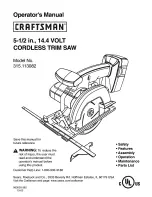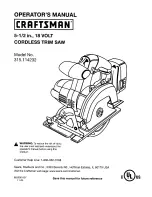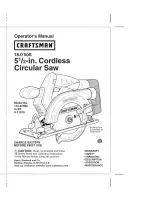
55
GB
f) If operating a power tool in a damp location
is unavoidable, use a residual current device
(RCD) protected supply.
Use of an RCD reduces the
risk of electric shock.
3) Personal safety
a) Stay alert, watch what you are doing and use
common sense when operating a power tool.
Do not use a power tool while you are tired or
under the influence of drugs, alcohol or medica-
tion.
A moment of inattention while operating power tools
may result in serious personal injury.
b) Use personal protective equipment. Always
wear eye protection.
Protective equipment such as
a dust mask, non-skid safety shoes, hard hat or hearing
protection used for appropriate conditions will reduce per-
sonal injuries.
c) Prevent unintentional starting. Ensure the
switch is in the off-position before connecting to
power source and/or battery pack, picking up
or carrying the tool.
Carrying power tools with your
finger on the switch or energising power tools that have the
switch on invites accidents.
d) Remove any adjusting key or wrench before
turning the power tool on.
A wrench or a key left
attached to a rotating part of the power tool may result in
personal injury.
e) Do not overreach. Keep proper footing and
balance at all times.
This enables better control of the
power tool in unexpected situations.
f) Dress properly. Do not wear loose clothing or
jewellery. Keep your hair and clothing away
from moving parts.
Loose clothes, jewellery or long
hair can be caught in moving parts.
g) If devices are provided for the connection of
dust extraction and collection facilities, ensure
these are connected and properly used.
Use of
dust collection can reduce dust-related hazards.
h) Do not let familiarity gained from frequent use
of power tools allow you to become compla-
cent and ignore power tool safety principles.
A
careless action can cause severe injury within a fraction of
a second.
4) Power tool use and care
a) Do not force the power tool. Use the correct
power tool for your application.
The correct power
tool will do the job better and safer at the rate for which it
was designed.
b) Do not use the power tool if the switch does not
turn it on and off.
Any power tool that cannot be con-
trolled with the switch is dangerous and must be repaired.
c) Disconnect the plug from the power source
and/or remove the battery pack, if detachable,
from the power tool before making any adjust-
ments, changing parts of insert tools, or storing
power tools.
Such preventive safety measures reduce
the risk of starting the power tool accidentally.
d) Store idle power tools out of the reach of chil-
dren and do not allow persons unfamiliar with
the power tool or these instructions to oper-
ate the power tool.
Power tools are dangerous in the
hands of untrained users.
e) Maintain power tools and insert tools. Check
for misalignment or binding of moving parts,
breakage of parts and any other condition that
may affect the power tool’s operation. If dam-
aged, have the power tool repaired before
use.
Many accidents are caused by poorly maintained
power tools.
f) Keep cutting tools sharp and clean.
Properly main-
tained cutting tools with sharp cutting edges are less likely
to bind and are easier to control.
g) Use the power tool, accessories and tool bits
etc. in accordance with these instructions, tak-
ing into account the working conditions and the
work to be performed.
Use of the power tool for
operations different from those intended could result in a
hazardous situation.
h) Keep handles and grasping surfaces dry, clean
and free from oil and grease.
Slippery handles and
grasping surfaces do not allow for safe handling and con-
trol of the tool in unexpected situations.
Service
a) Have your power tool serviced by a qualified
repair person using only identical replacement
parts.
This will ensure that the safety of the power tool is
maintained.
m
WARNING
This electric tool generates an electromagnetic field during op-
eration. This field can impair active or passive medical implants
under certain conditions. In order to prevent the risk of serious
or deadly injuries, we recommend that persons with medical
implants consult with their physician and the manufacturer of
the medical implant prior to operating the electric tool.
Safety instructions for table saws
Guarding related warnings
a) Keep guards in place. Guards must be in work-
ing order and be properly mounted.
A guard that
is loose, damaged, or is not functioning correctly must be
repaired or replaced.
b) Always use saw blade guard, riving knife and
for every through–cutting operation.
For through-
cutting operations where the saw blade cuts completely
through the thickness of the workpiece, the guard and
other safety devices help reduce the risk of injury.
c) After completing working procedures where
the removal of the protective cover and/or
riving knife is necessary (e.g. producing folds
and rebating, cutting grooves or cutting with a
turnover), the protective system must be imme-
diately reattached.
The guard helps to reduce the risk
of injury.
Содержание 322850 1901
Страница 4: ...10 6 6 7 9 8 8 14 11 4a 12 14 13 24 32 34 20 21 33 25 23 4 35 20 36 3 6 3 31 max 5mm...
Страница 5: ...16 18 14 19 20 15 17 21 45 8 17 16a 37 9 16 17 16 17 18 19 40 39 16a 38 38 16a 17...
Страница 6: ...22 24 23 41 25 42 43 43 42 44 44...
Страница 56: ...50...
Страница 72: ...66...
Страница 74: ......
















































